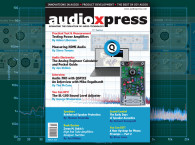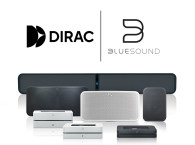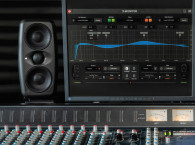 audioXpress December 2021 is now available and it offers a broad and valuable combination of articles from industry experts. Start by getting the broad and eye-opening perspective on available technologies and platforms applied to Room Correction and Calibration. In our latest Room Correction and Speaker Calibration Market Update, gain perspective about how different market segments are approaching the Self-Calibrating Loudspeaker, a vision for the ultimate use of "room-sensing,” and “spatial awareness” approaches to speaker optimization.
audioXpress December 2021 is now available and it offers a broad and valuable combination of articles from industry experts. Start by getting the broad and eye-opening perspective on available technologies and platforms applied to Room Correction and Calibration. In our latest Room Correction and Speaker Calibration Market Update, gain perspective about how different market segments are approaching the Self-Calibrating Loudspeaker, a vision for the ultimate use of "room-sensing,” and “spatial awareness” approaches to speaker optimization.
This extensive report explores available technologies and platforms applied to room and speaker frequency response correction and adjustments, looking at industry efforts toward configurable audio processing and room compensation approaches for advanced, adjustable active speakers. That includes sound response emulation concepts, variable acoustics, and sound calibration for any targeted audio reproduction system.
And this topic is even further expanded with an exclusive article by Lars-Johan Brännmark (Chief Scientist, Dirac Research AB) unveiling the "Arrival of Spatial Room Correction Technology." Written from the perspective of the Swedish digital signal processing specialist company that created one of the market's leading room-correction solutions, this article anticipates the requirement for the same DSP room correction approach to be applied in complex multichannel setups, intended for immersive audio reproduction. Dirac’s latest approach to the challenge proposes a solution where all speakers in an audio system work to optimize the reproduction of each input channel in an optimal way.
Next up, in "Directivity Measurement of In-Wall Loudspeakers," authors Christian Bellmann and Ruben Hauschild (Klippel GmbH), and Mattia Cobianchi (Bowers & Wilkins) share their research on new requirements for the measurement of these installation speakers. The directional characteristics are an especially important factor, because the direction in which a loudspeaker emits sound highly affects the interaction with the listening room and the listening experience. The authors' research addressed the requirement using holographic directivity to address the way the directional characteristics interact with the listening room.
Offering a practical hands-on review of a full system for multiroom audio, Thomas Perazella writes about the possibilities offered by the Dayton Audio DAX88 - Eight-Source, Eight-Zone - Distributed Audio Matrix Amplifier. As Perazella was set to create a whole-house audio system in his home, he learned about the impending launch of the DAX88 system and received one of the first units intended for beta testers. The article explores the system’s main features and setup.
Still directly related with speakers, but already expanding on the DIY perspective, Richard Modafferi describes a crossover design and build project, which he created to retrofit already-built Solstice Tower Speaker Kits, sold by Parts Express. Starting by expanding his own work on the Pearl loudspeakers by Joseph Audio, in the late 1990s, Modafferi achieved an improved crossover design, leading to a patent application that was validated in 2020. The benefits are now easily reproducible to be enjoyed in the affordable but extremely good quality Solstice speakers, a bass reflex loading design by Jeff Bagby.

In this edition's Sound Control column, Richard Honeycutt, talks about the challenges of capturing the sounds of audience members. Ever since the beginning of modern architectural acoustics, experts have focused on reverberation time as the most important parameter in auditorium performance. However, Richard Honeycutt believes that determining the direction from which sound arrives at the listeners’ ears might be the real key to effectively miking the audience.
Diving straight into Audio Electronics, this edition features the first of a two-part article by Frans de Wit, "Thinking About DC Power Supplies." This article was written with the ambitious intent to cover multiple circuit types for “power supplies” or better “power sources” for high-end audio systems. Resourcing to LTspice simulation software as a tool to evaluate the performance, it covers the types of circuits most likely to be used as the power source for high-quality preamplifier or line-level amplifier. If you are interested in high-quality audio circuits or you need a high-quality low power ‘power source’ then this is an article for you. There is a companion, downloadable, set of files with this article that contains all the source material needed to reproduce the schematic circuits and plotted diagrams.
And for those readers following the fascinating article series by Morty Tarr on "Cascodes, Folded Cascodes, and Current Mirrors," this edition contains the final section with important aspects of amplifier design. In the first two parts of this article series, Tarr discussed the technical merits of cascodes and related circuits. This useful addendum covers a simple test circuit for matching FET devices, the fascinating story of the Blowtorch Line Stage design, and additional notes on inverting and non-inverting amplifier stages and integrators.
There is also an additional project by Michel Nieuwenhuizen that will greatly appeal to more technical DIYers and vinyl enthusiasts. In "Simple Xtal-Based Motor Control for Turntables," the author offers a great way to deal with issues in mains frequency for critical record listening with special circuit for motor control using an Arduino microcontroller board.
 The December 2021 edition closes with another enjoyable exploration by Richard Honeycutt on the fascinating world of Hollow-State Electronics. This time, he discusses subminiature vacuum tubes and talks to Phil Taylor, the founder of Effectrode Thermionic, a company creatively exploring miniature and subminiature vacuum tubes for guitar effect pedals.
The December 2021 edition closes with another enjoyable exploration by Richard Honeycutt on the fascinating world of Hollow-State Electronics. This time, he discusses subminiature vacuum tubes and talks to Phil Taylor, the founder of Effectrode Thermionic, a company creatively exploring miniature and subminiature vacuum tubes for guitar effect pedals.
audioXpress is published 12 times per year, and available in print and online. Subscribing to the digital online version allows immediate access and is available here: www.audioxpress.com/page/audioXpress-Subscription-Services.html
If you wish to buy a single printed issue or the complete audioXpress archive on USB, from 2000 to 2021 (yes, including the latest issue), just visit our online shop at www.cc-webshop.com
Don't miss out, get your copy of audioXpress right now at www.gotomyxpress.com






